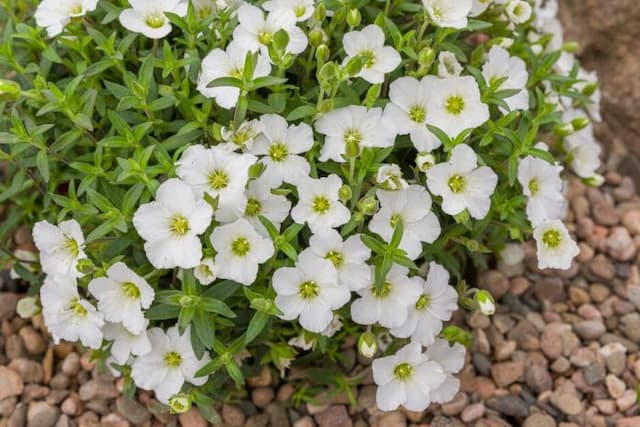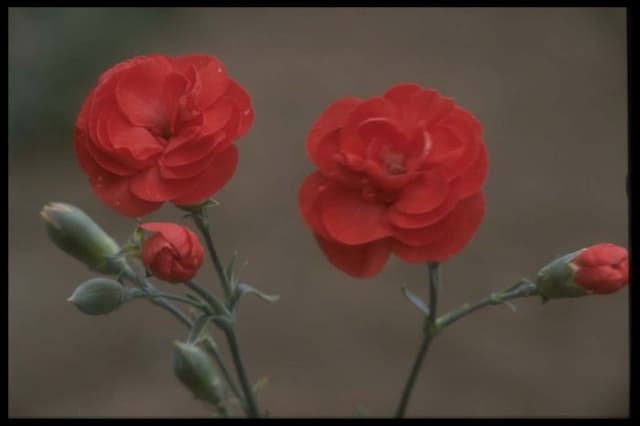Catchfly Silene schafta 'Shell Pink'

ABOUT
The Silene schafta 'Shell Pink', commonly known as Autumn Catchfly, is a charming perennial prized for its delightful display of blooms. Its most striking feature is the profusion of pale pink flowers that create a soft, pastel blanket of color. These blossoms typically have a delicate, somewhat round shape with a subtle yet enchanting blush hue that can add a gentle touch of romance to any garden space. The leaves of the Autumn Catchfly provide a pleasing backdrop to the pink flowers. They are generally small, with a smooth texture and a blue-green tint. The foliage is often dense and forms a compact, low-growing mat that serves as an attractive ground cover throughout the blooming season. As the blooms unfurl, they reveal a crown of slightly darker pink at the center, enhancing the flower's depth and allure. The petals are typically notched, adding texture and visual interest to each individual bloom. Furthermore, the mass of flowers exudes a delicate, sweet fragrance that can attract butterflies and other beneficial pollinators, adding to the overall appeal of this garden favorite. This plant's growth habit is robust, forming tight clusters of foliage and flowers that create a lush and vibrant tapestry when in full bloom. Its evergreen character in certain climates ensures that even when not in bloom, the Autumn Catchfly retains its aesthetic appeal with its dense foliage.
About this plant
 Names
NamesFamily
Caryophyllaceae
Synonyms
Autumn Catchfly, Shell Pink Catchfly
Common names
Silene schafta 'Shell Pink'.
 Toxicity
ToxicityTo humans
Catchfly 'Shell Pink' is not widely known to be toxic to humans. There is limited information suggesting any severe toxicity or symptoms of poisoning from ingesting this plant. However, it is generally advisable to avoid eating ornamental plants due to potential individual sensitivities or the presence of harmful substances not well studied.
To pets
Catchfly 'Shell Pink' is also not specifically reported to be toxic to pets. While the risk of severe toxicity seems low, ingestion of non-food plants can sometimes result in mild gastrointestinal upset for pets, including symptoms like vomiting or diarrhea. As a precaution, keep pets from consuming ornamental plants.
 Characteristics
CharacteristicsLife cycle
Perennials
Foliage type
Evergreen
Color of leaves
Green
Flower color
Pink
Height
1 foot [30 cm]
Spread
1 foot [30 cm]
Plant type
Herb
Hardiness zones
5
Native area
Middle East
Benefits
 General Benefits
General Benefits- Easy to Grow: Silene schafta 'Shell Pink', also known as catchfly, is known for being a low-maintenance plant that is easy to grow in a variety of conditions.
- Attracts pollinators: The flowers attract butterflies and other beneficial insects, promoting a healthy ecosystem in the garden.
- Drought tolerant: Once established, catchfly is quite drought-resistant, making it suitable for xeriscaping and water-efficient gardening.
- Ground cover: It can serve as an effective ground cover, suppressing weeds and reducing soil erosion.
- Ornamental value: With its attractive pink blooms, this variety of catchfly adds aesthetic appeal to garden beds, borders, and rockeries.
- Extended blooming period: It has a long flowering season, providing color and interest in the garden for an extended period.
- Compact growth: Its small, mounding habit makes it an ideal choice for smaller gardens, containers, and spaces with limited room.
 Medical Properties
Medical PropertiesThis plant is not used for medical purposes.
 Air-purifying Qualities
Air-purifying QualitiesThis plant is not specifically known for air purifying qualities.
 Other Uses
Other Uses- Creative plant arrangements: Silene schafta 'Shell Pink' can be used to add a pastel color scheme to succulent arrangements or rock gardens due to its delicate pink blooms and compact growth habit.
- Floral crafts: The flowers of 'Shell Pink' can be used in dried flower arrangements or pressed flower projects, as the blooms retain much of their color when dried properly.
- Erosion control: This plant can be utilized on slopes or in areas prone to soil erosion as its root system helps to stabilize the ground.
- Educational tools: Schools and educational programs can use 'Shell Pink' to teach students about plant biology, pollination, and the growth cycle of perennials.
- Garden borders: It can be planted along walkways, paths, or garden borders to define space with its low-growing, mat-like foliage.
- Art inspiration: Artists and designers can take inspiration from the shape and color of Silene schafta 'Shell Pink' for patterns, prints, and color palettes in their work.
- Fairy gardens: Due to its small size and enchanting appearance, 'Shell Pink' is fitting for use in miniature fairy gardens and other whimsical garden designs.
- Ground cover: In landscaping, 'Shell Pink' can serve as an attractive ground cover that requires minimal maintenance once established.
- Photography: The blooms of 'Shell Pink' are photogenic and make an excellent subject for nature photographers seeking to capture the beauty of garden plants.
- Night garden addition: This plant can be incorporated into a night-blooming garden, as the light pink flowers stand out in the dusk, creating visual interest in the evening hours.
Interesting Facts
 Feng Shui
Feng ShuiThe Silene is not used in Feng Shui practice.
 Zodiac Sign Compitability
Zodiac Sign CompitabilityThe Silene is not used in astrology practice.
 Plant Symbolism
Plant Symbolism- Love and Affection: With its delicate pink flowers, Silene schafta 'Shell Pink', commonly known as Catchfly, often symbolizes a gentle and tender love, evoking a sense of caring and emotional closeness.
- Transient Beauty: Catchfly blooms may be short-lived, reflecting the fleeting nature of beauty and reminding us to appreciate the present moment.
- Adhesion: The common name 'Catchfly' comes from the sticky stems that can trap small insects. This stickiness can be symbolically linked to attachment and holding on to what is important in one's life.
 Water
WaterThe Maiden Pink plant prefers to be watered when the top inch of soil feels dry to the touch. A good method is to water deeply but infrequently, ensuring that the soil is moist but not waterlogged. Typically, watering once a week with approximately 1 gallon of water is sufficient, but this may vary depending on climate and weather conditions. During hot, dry periods, the plant may require more frequent watering, whereas less watering is needed during cool, wet periods. Always check the soil moisture level before watering to avoid overwatering.
 Light
LightMaiden Pink thrives in full sun to partial shade. The ideal spot for the plant is an area that receives at least 6 to 8 hours of direct sunlight each day. It can tolerate some light afternoon shade, particularly in hot climates, but too much shade will lead to sparse blooms and leggy growth.
 Temperature
TemperatureMaiden Pink does well in a wide range of temperatures but prefers a temperate climate. The plant is hardy and can survive temperatures as low as 20°F but performs best when temperatures range between 60°F and 75°F. It can handle occasional, brief exposures to higher temperatures, but prolonged heat above 85°F may stress the plant.
 Pruning
PruningMaiden Pink benefits from occasional pruning to maintain its shape and encourage denser growth. Snip off spent flowers to promote further blooming and cut back the foliage by one-third after flowering to rejuvenate the plant. The best time for pruning is late summer or early fall, after the plant has finished its main flowering period.
 Cleaning
CleaningAs needed
 Soil
SoilAutumn Catchfly thrives in well-draining soil with a mix of loam, peat, and sand, with a pH ranging from 6.0 to 7.0. Enrich the soil with organic compost to improve fertility.
 Repotting
RepottingAutumn Catchfly doesn't require frequent repotting; do so every 2-3 years or when it outgrows its container.
 Humidity & Misting
Humidity & MistingAutumn Catchfly prefers moderate humidity levels but is quite adaptable and doesn't need specific humidity adjustments.
 Suitable locations
Suitable locationsIndoor
Ensure bright light, moderate water, and good air flow for Autumn Catchfly indoors.
Outdoor
Plant Autumn Catchfly in full sun to partial shade, in well-draining soil.
Hardiness zone
3-8 USDA
 Life cycle
Life cycleThe life of Campion 'Shell Pink', like other perennials, begins with germination, where its seed absorbs water, swells, and sprouts, emerging as a seedling with initial roots and shoots. This stage progresses to vegetative growth, during which the plant develops a rosette of leaves and a deep root system, focusing on accumulating resources and establishing itself. As it matures, Campion 'Shell Pink' enters the flowering stage, producing clusters of light pink blooms that attract pollinators for sexual reproduction, typically in late spring to summer. Successful pollination leads to seed development, where fertilized flowers gradually form seed capsules containing numerous tiny seeds. Once the seeds are mature, they are dispersed into the environment, commonly by wind or mechanical movement, to start the next generation of plants. During the winter or unfavorable conditions, Campion 'Shell Pink' may become dormant, conserving energy and resources, with growth and flowering resuming in the following suitable growth season.
 Propogation
PropogationPropogation time
Spring to Summer
The ideal time to propagate Silene schafta 'Shell Pink', commonly known as Catchfly, is in the spring after the threat of frost has passed or in the early fall to allow sufficient time for establishment before winter. The most popular method of propagation for this plant is by division. This involves gently separating the dense clumps into smaller sections, each with some roots and shoots, using your hands or a sharp spade. It is important to immediately replant the divisions at the same depth they were growing at before and to water them thoroughly. Divisions should be spaced about 6 to 12 inches (15 to 30 centimeters) apart to ensure proper growth and ventilation. This technique quickly produces new plants that are identical to the parent and typically results in a vigorous growth response as the divided plants have room to develop and access to more resources.


![Pink [Tequila Sunrise]](/_next/image?url=https%3A%2F%2Fplants-admin.emdemapps.com%2Fimages%2Fplants%2F%2Fimages%2F604b5d995d06e.png&w=640&q=75)






